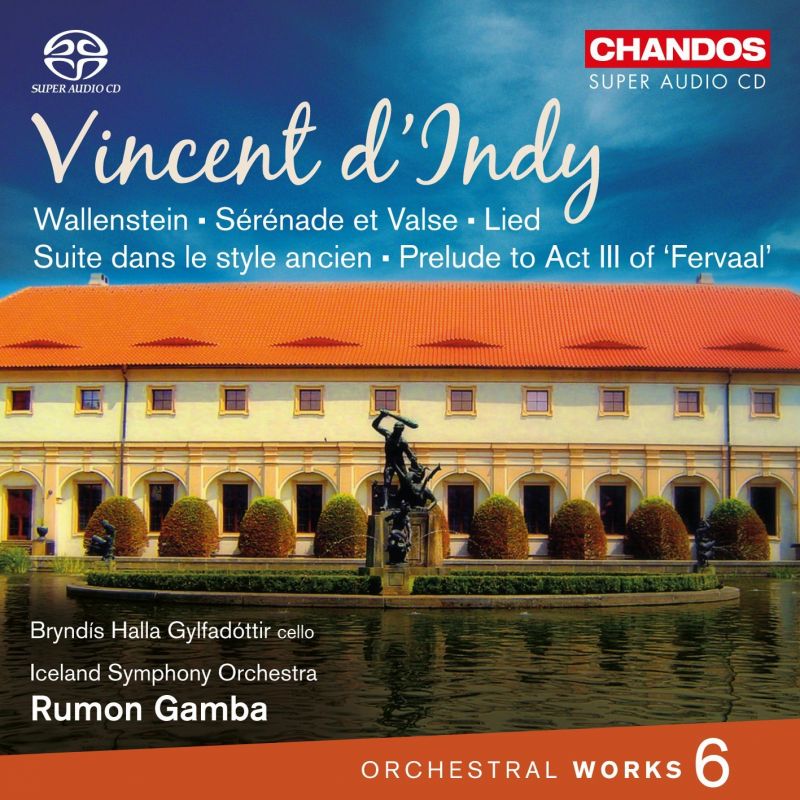D'INDY Orchestral Works Vol 6
View record and artist detailsRecord and Artist Details
Composer or Director: (Paul Marie Théodore) Vincent D'Indy
Genre:
Orchestral
Label: Chandos
Magazine Review Date: 07/2015
Media Format: Super Audio CD
Media Runtime: 74
Mastering:
DDD
Catalogue Number: CHSA5157

Tracks:
| Composition | Artist Credit |
|---|---|
| Wallenstein |
(Paul Marie Théodore) Vincent D'Indy, Composer
(Paul Marie Théodore) Vincent D'Indy, Composer Iceland Symphony Orchestra Rumon Gamba, Conductor |
| Lied |
(Paul Marie Théodore) Vincent D'Indy, Composer
(Paul Marie Théodore) Vincent D'Indy, Composer Bryndís Halla Gylfadóttir, Cello Iceland Symphony Orchestra Rumon Gamba, Conductor |
| Suite dans le style ancien |
(Paul Marie Théodore) Vincent D'Indy, Composer
(Paul Marie Théodore) Vincent D'Indy, Composer Iceland Symphony Orchestra Rumon Gamba, Conductor |
| Sérénade et Valse |
(Paul Marie Théodore) Vincent D'Indy, Composer
(Paul Marie Théodore) Vincent D'Indy, Composer Iceland Symphony Orchestra Rumon Gamba, Conductor |
| Fervaal, Movement: Prelude |
(Paul Marie Théodore) Vincent D'Indy, Composer
(Paul Marie Théodore) Vincent D'Indy, Composer Iceland Symphony Orchestra Rumon Gamba, Conductor |
Author: Tim Ashley
The main work here is Wallenstein, completed in 1879, a symphonic trilogy based on Schiller, usually described as a response to The Ring, which d’Indy heard at Bayreuth in 1876. A variant of Wagner’s sword motif characterises the titular hero, a treacherous army officer trapped Wotan-like in schemes of his own devising. Yet the melodic contours suggest the predominant influence of Berlioz; the cyclic form derives from Franck; and a weird chordal sequence depicting the superstitious Wallenstein’s astrological consultations startlingly prefigures the Nietzsche setting in Mahler’s Third Symphony.
Elsewhere, we find comparable links and overtones. The 1897 opera Fervaal is indebted to Parsifal, its Act 3 Prelude pivoting back to Klingsor’s incantations and forward to Pelléas. Suite dans le style ancien is not so much a work of Rococo pastiche as an astringent intimation of 20th-century neo-classicism. The beautiful Lied for cello and orchestra invites comparisons with Massenet, a rival of whom d’Indy was not particularly fond.
Gamba’s conducting evinces the care and thought characteristic of the retrospective as a whole. There’s an admirable awareness of the crafted sensuousness of d’Indy’s textures, the slightly studied novelty of his compositional style. The Iceland Symphony Orchestra’s brass glare a bit, though the playing is judiciously honed. Cellist Bryndís Halla Gylfadóttir sounds very svelte in the Lied. D’Indy’s reabsorption into the mainstream is a questionable prospect at best. But the series forcefully reminds us of his achievement and importance.
Discover the world's largest classical music catalogue with Presto Music.

Gramophone Digital Club
- Digital Edition
- Digital Archive
- Reviews Database
- Full website access
From £8.75 / month
Subscribe
Gramophone Full Club
- Print Edition
- Digital Edition
- Digital Archive
- Reviews Database
- Full website access
From £11.00 / month
Subscribe
If you are a library, university or other organisation that would be interested in an institutional subscription to Gramophone please click here for further information.




